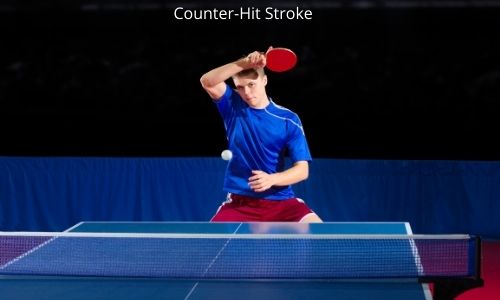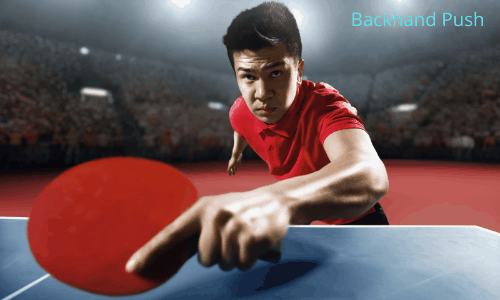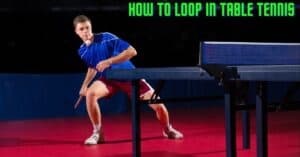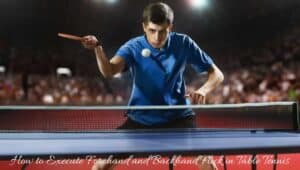Before learning the different strokes in table tennis, you have to ensure that you have adopted the right table tennis grip and learned the 4 basic table tennis strokes.
You also have to ensure that you have gathered knowledge of the different types of spin in table tennis and how to use the angle of your racket to brush the ball at different contact points to create different spins.
If you are serious and eager to enter into the advanced level to compete with others, then you should first cover the basic skills of table tennis. After completion of the basic skills, learn the advanced learning of strokes in table tennis.
In the game of table tennis, strokes are of two types. One is offensive strokes and another one is defensive strokes.
- Hit (Offensive)
- Flick (Offensive)
- Counter-Hit (Offensive)
- Smash (Offensive)
- Loop (Offensive)
- Push (Defensive)
- Block (Defensive)
- Chop (Defensive)
- Lob (Defensive)
What are the Offensive Strokes in Table Tennis?
Today’s modern table tennis is dominated by offensive players. So to be good at table tennis, you have to learn the skills for the proper execution of offensive strokes to dominate your opponent.
The offensive strokes are of five types.
Hit
It is one of the strokes in table tennis that offensive players use to continue the rally and to keep the ball in position. When you hit the ball, your bat will move perpendicular to the direction of the ball travel, so that the ball propels back to your opponent’s side.
Hit is generally characterized by a stroke to transfer the energy to create speed, not spin. So, when you hit the ball, it does not produce any arc. You should stand close to the end line and hit the ball with more energy to move the ball fast enough to beat your opponent.
Flick
Flick is a tricky shot with quick wrist action. If you receive a ball close to the net with lots of backspin, then the best attacking option is to flick the ball.
When you get the ball at the end of the table, you have the opportunity to swing your bat on a larger arc. But when you get the ball close to the net with backspin, you will not get the back-swing to create high speed. Still, you can attack the ball by leaning over the table and flicking the ball with quick wrist action.
To make a flick:
- Get close to the ball by forwarding your right foot (for a right-hander) under the table.
- Open your wrist and take your hand back to create the swing for generating power.
- When the ball approaches you, forward your bat to make the swing.
- Hit the ball at the top of the bounce.
- Follow through and come back to the ready position.
To counter the spin, your bat angle should be open when you are facing the backspin and slightly closed for the topspin.
A good flick will give a point to your wallet as it angled away from your opponent with high speed.
Counter-hit

Counter-hit is a drive shot in table tennis that capitalizes on the incoming speed and spin to generate a speedy well-paced ball with less effort.
In the forehand counter-hit:
- Your stance is square-on or slightly side-on against the table with your bat next right to you (if you are a right-hander) at your waist height.
- Your upper and lower arms should form an “L” shape.
- The forehand side of your bat should face towards the direction where you want your ball to go.
- Forward your bat and strike the ball at the top of the bounce.
- Complete your action by following the bat up to your head height.
In a backhand counter hit:
- Your Bat is in front of you at the height of your belly.
- You should take a square-on stance by leaning forward toward the direction where you want your ball to go.
- Forward your bat and strike the ball with the backhand side.
- Follow your bat up to the waist height.
The counter-hit is the stroke that you must learn before moving to more advanced table tennis strokes.
Smash

Smash is all about power in table tennis. The goal of a smash stroke is to generate maximum speed, not spin. You should use smash at the time when you get a ball close to or above your shoulder height.
- When you prepare for this shot, stand side-on the table with your weight on the back foot.
- At the time of making the shot, transfer your weight from the back foot to the front foot. This will help you generate maximum power.
Smash is of two types, forehand smash, and backhand smash.
In case of a forehand smash, make a backswing around your shoulder height. Then forward your bat quickly, facing toward your opponent’s side to hit the ball.
For a backhand smash, the starting position of the stroke is in front of your shoulder, not beyond your shoulder, as in the case of a forehand stroke.
As the aim is to get maximum speed not spin, the hit for a smash stroke is flat and the contact point is in the middle of the ball.
Loop
Loop is an advanced table tennis offensive stroke. It is a heavy topspin stroke. Modern table tennis is mainly dominated by loop shots.


- The rotation of the trunk is very important in a looping shot.
- Be sure, to bend your knees, rotate your trunk, and then swing your racket from the knee height to the head height.
- Keep your elbow higher than your wrist during the rotation.
- Your wrist has a very important role in a looping shot.
- Keep it flexible and give the last-minute slap to the ball to increase the amount of spin and speed.
- To counter a backspin ball with a looping shot, your racket should start from low with a less closed angle than to counter a topspin.
In the forehand topspin, your stance is side-on the table to give your bat space for the swing. But in backhand topspin, your stance is square on the table.
What are the Defensive Strokes in Table Tennis?
Learning defensive strokes is of great importance for those whose aim is to be defensive players. For the attackers, it is also important to learn the defensive strokes as it creates the opportunity for an attacking stroke.
When there are two attackers in a table tennis game, in many situations, one of them is bound to go for the defensive mode to continue the rally.
You can’t opt for the attacking strokes right from the beginning. Like, when you are returning a low heavy backspin short serve, you have no choice but to go for a defensive push shot. Also, the proper execution of a defensive stroke creates the opportunity for a killer attacking shot.
In general, the defensive table tennis strokes are of four types.
Push
Push is a soft defensive stroke and great for returning a serve. If you face a high backspin short serve, the push is the easiest option to return the ball.

In forehand push, your playing hand should be next to you with your elbow close to your body. As the ball approaches you, move your right foot and your body towards the ball. Raise your lower arm and then bring it down in a quicker motion to brush under the ball.

To play backhand push, stand close to the table and hold your racket in front of your body. The forearm of your playing hand moves in a horizontal plane from the elbow. Push the racket as a forwarding motion to strike underneath the ball on the top of the bounce.
To be more effective, increase the racket speed for more backspin and keep the ball as low as possible over the net.
Block
Block is all about the timing of your stroke. It is a shorter version of the counter-hit.
The block shot is used when you don’t have time to go for a bigger swing of your racket. Rather, it is easy to use the opponent’s speed and spin.
Stand close to the table and take a square-on stance. Forward your bat and strike the ball just after the bounce at the net height level.
To block a coming topspin ball, you should close the angle of your racket. If you face a more topspin ball, the angle of the racket will be more closed and if you face a less topspin ball, the angle of your racket will be less closed.
Chop

It’s a defensive table tennis stroke that involves heavy backspin. Chop shot is very effective when are away from the table to continue the rally.
For chop, you have to stand side on the table and start from the height of your head. The racket will come in a downward motion to brush underneath the ball and ends at your knee height.
If you face a fast topspin ball, your bat will move downward, whereas, for a slow topspin ball, the bat movement will be downward as well as forward.
If you are a defensive player, a chop shot is a good weapon in your armory to counter the topspin of the attacker.
Lob
The lob is one of the defensive strokes in table tennis that allows you to lift the ball away from the table. You can lob the ball with a slight close angle to impart topspin to the ball to move your opponent back from the table.
You can start your bat from your knee height and follow up to above the head height.
To be effective, you should lob the ball near the end of the table which will push your opponent further back. Otherwise, if you lob short, he will smash the ball which would be hard to return.
Final Thought
As I have earlier said, you need tons of practice to gain the control to execute these strokes at your will.
There are several ways to practice like you can practice with your partner, with the help of a robot or a multi-ball season can be great for you.
If you are interested in videos, check PingSkills for excellent table tennis coaching tutorials that will help you improve your game.
And finally, listen to every word your coach is saying. If you can follow him with passion and determination, nothing can stop you from becoming a great player.



